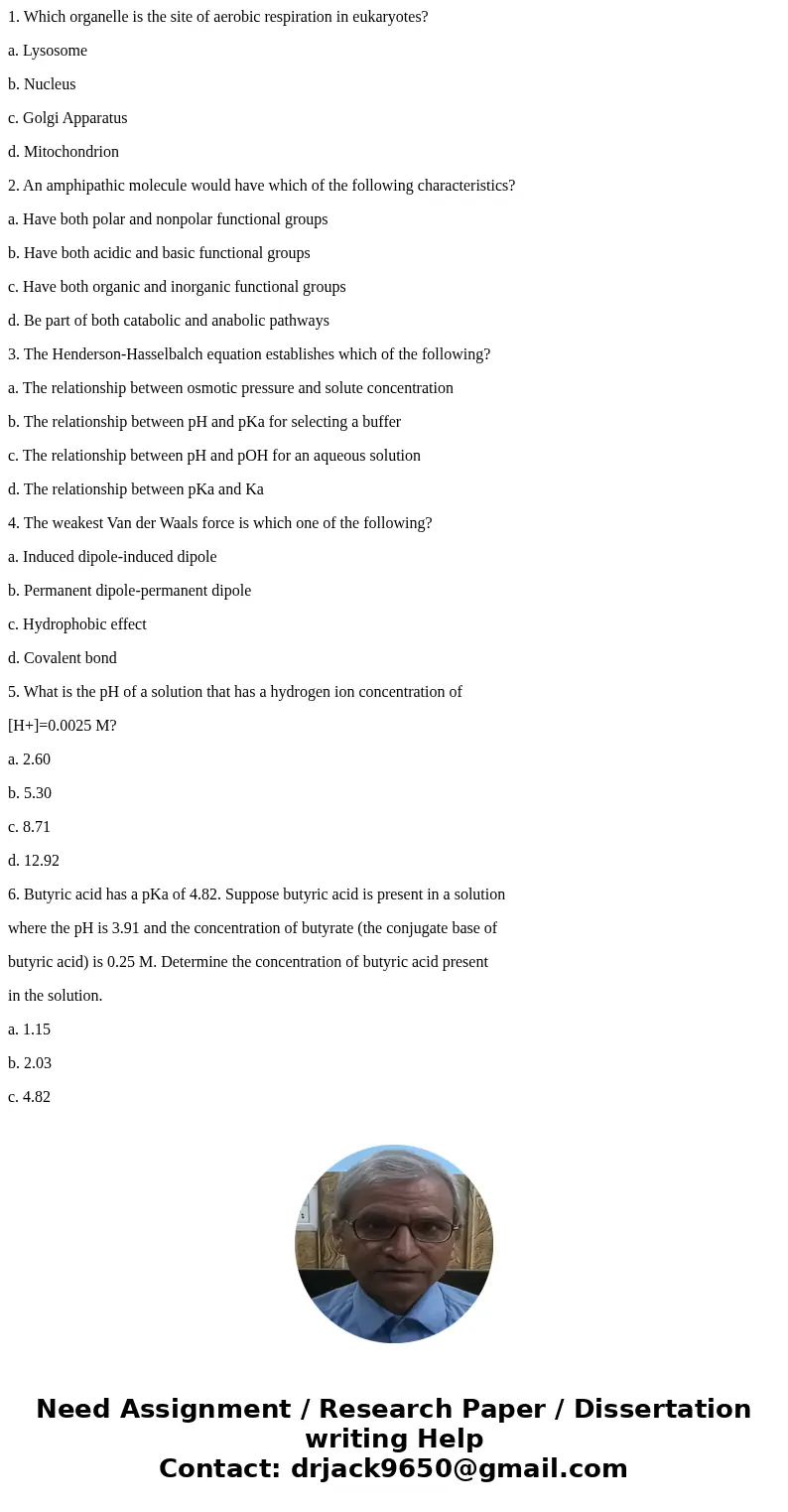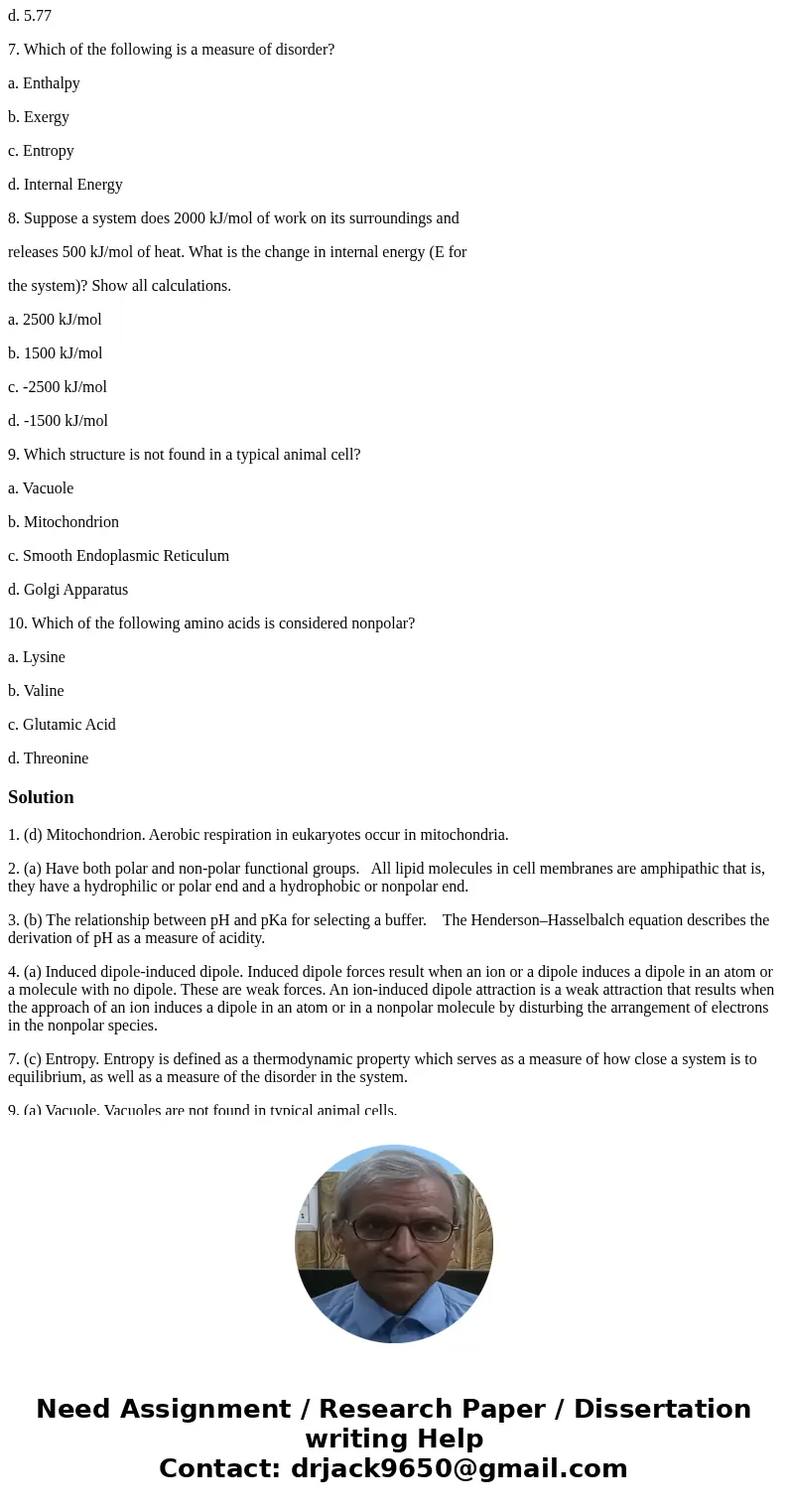1 Which organelle is the site of aerobic respiration in euka
1. Which organelle is the site of aerobic respiration in eukaryotes?
a. Lysosome
b. Nucleus
c. Golgi Apparatus
d. Mitochondrion
2. An amphipathic molecule would have which of the following characteristics?
a. Have both polar and nonpolar functional groups
b. Have both acidic and basic functional groups
c. Have both organic and inorganic functional groups
d. Be part of both catabolic and anabolic pathways
3. The Henderson-Hasselbalch equation establishes which of the following?
a. The relationship between osmotic pressure and solute concentration
b. The relationship between pH and pKa for selecting a buffer
c. The relationship between pH and pOH for an aqueous solution
d. The relationship between pKa and Ka
4. The weakest Van der Waals force is which one of the following?
a. Induced dipole-induced dipole
b. Permanent dipole-permanent dipole
c. Hydrophobic effect
d. Covalent bond
5. What is the pH of a solution that has a hydrogen ion concentration of
[H+]=0.0025 M?
a. 2.60
b. 5.30
c. 8.71
d. 12.92
6. Butyric acid has a pKa of 4.82. Suppose butyric acid is present in a solution
where the pH is 3.91 and the concentration of butyrate (the conjugate base of
butyric acid) is 0.25 M. Determine the concentration of butyric acid present
in the solution.
a. 1.15
b. 2.03
c. 4.82
d. 5.77
7. Which of the following is a measure of disorder?
a. Enthalpy
b. Exergy
c. Entropy
d. Internal Energy
8. Suppose a system does 2000 kJ/mol of work on its surroundings and
releases 500 kJ/mol of heat. What is the change in internal energy (E for
the system)? Show all calculations.
a. 2500 kJ/mol
b. 1500 kJ/mol
c. -2500 kJ/mol
d. -1500 kJ/mol
9. Which structure is not found in a typical animal cell?
a. Vacuole
b. Mitochondrion
c. Smooth Endoplasmic Reticulum
d. Golgi Apparatus
10. Which of the following amino acids is considered nonpolar?
a. Lysine
b. Valine
c. Glutamic Acid
d. Threonine
Solution
1. (d) Mitochondrion. Aerobic respiration in eukaryotes occur in mitochondria.
2. (a) Have both polar and non-polar functional groups. All lipid molecules in cell membranes are amphipathic that is, they have a hydrophilic or polar end and a hydrophobic or nonpolar end.
3. (b) The relationship between pH and pKa for selecting a buffer. The Henderson–Hasselbalch equation describes the derivation of pH as a measure of acidity.
4. (a) Induced dipole-induced dipole. Induced dipole forces result when an ion or a dipole induces a dipole in an atom or a molecule with no dipole. These are weak forces. An ion-induced dipole attraction is a weak attraction that results when the approach of an ion induces a dipole in an atom or in a nonpolar molecule by disturbing the arrangement of electrons in the nonpolar species.
7. (c) Entropy. Entropy is defined as a thermodynamic property which serves as a measure of how close a system is to equilibrium, as well as a measure of the disorder in the system.
9. (a) Vacuole. Vacuoles are not found in typical animal cells.
10. (b) Valine. Valine is a non-polar amino acid.



 Homework Sourse
Homework Sourse